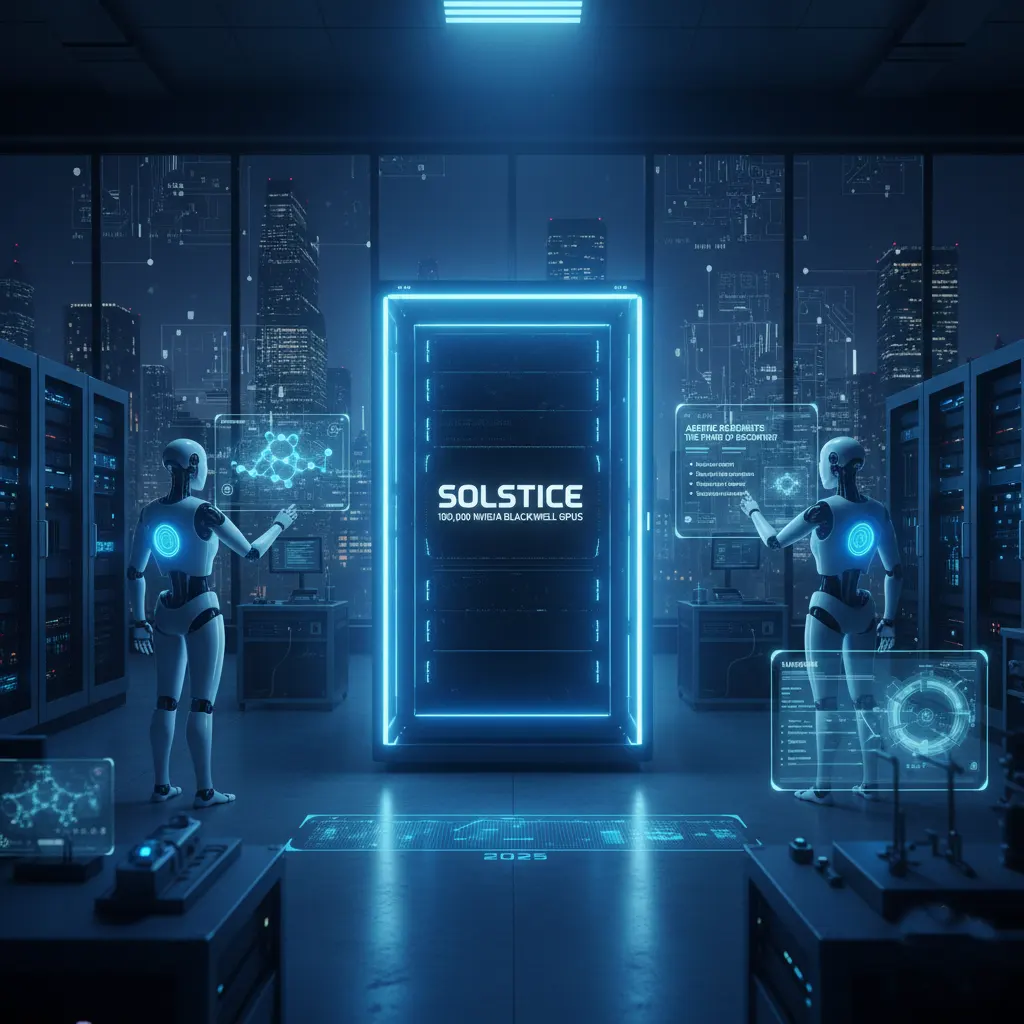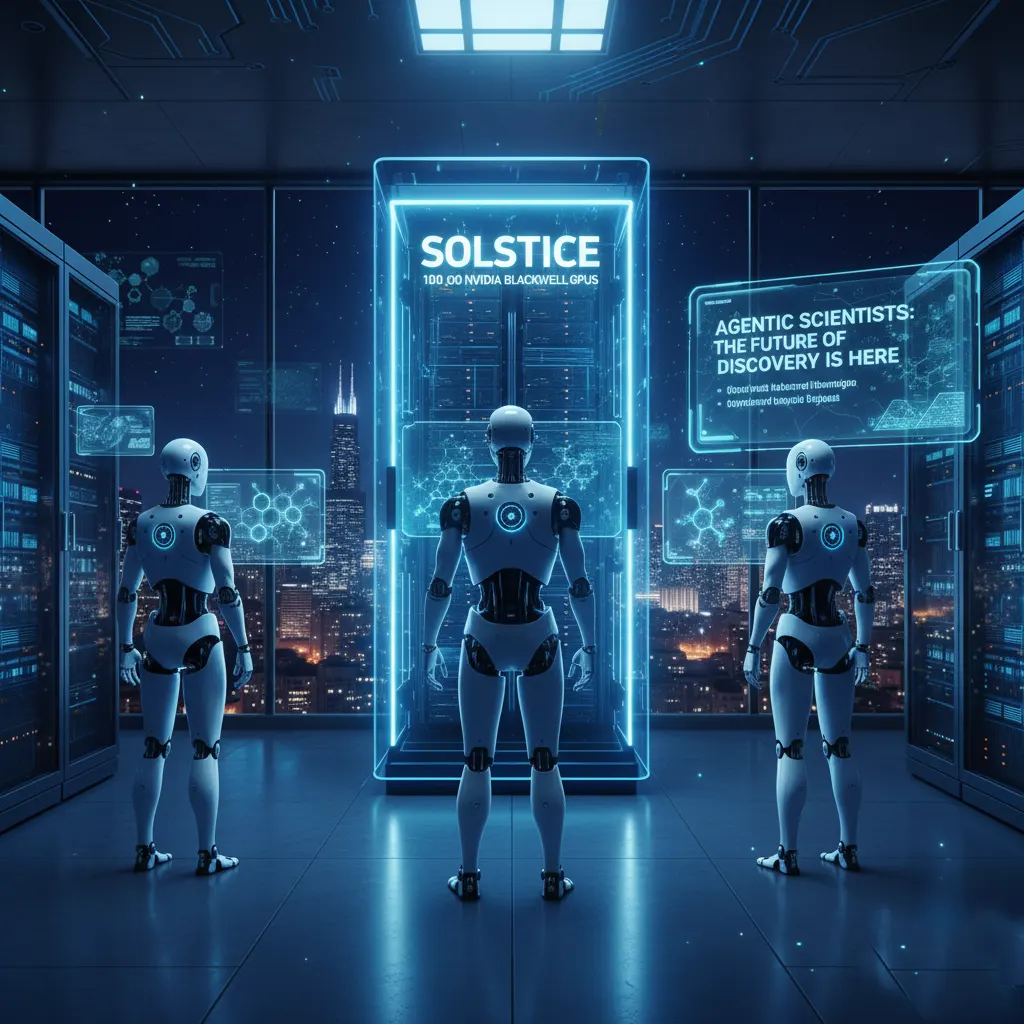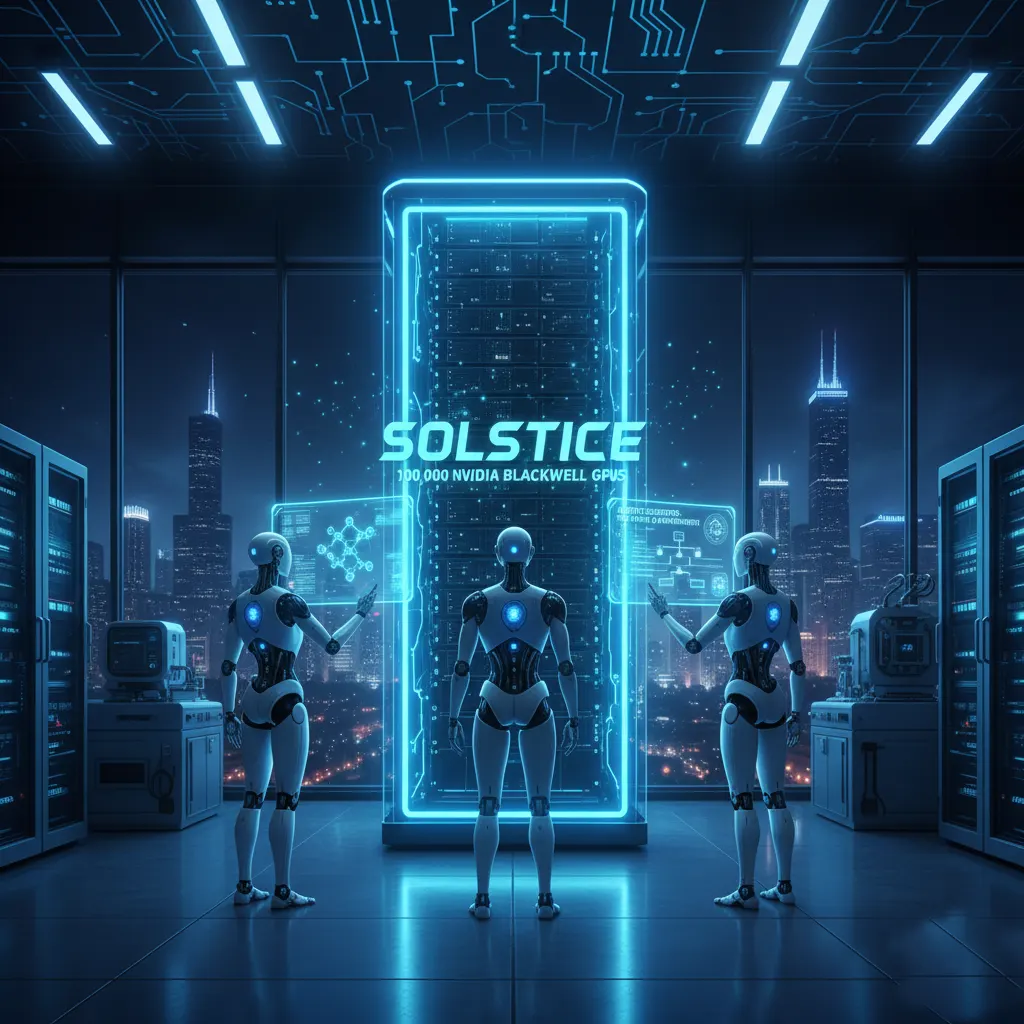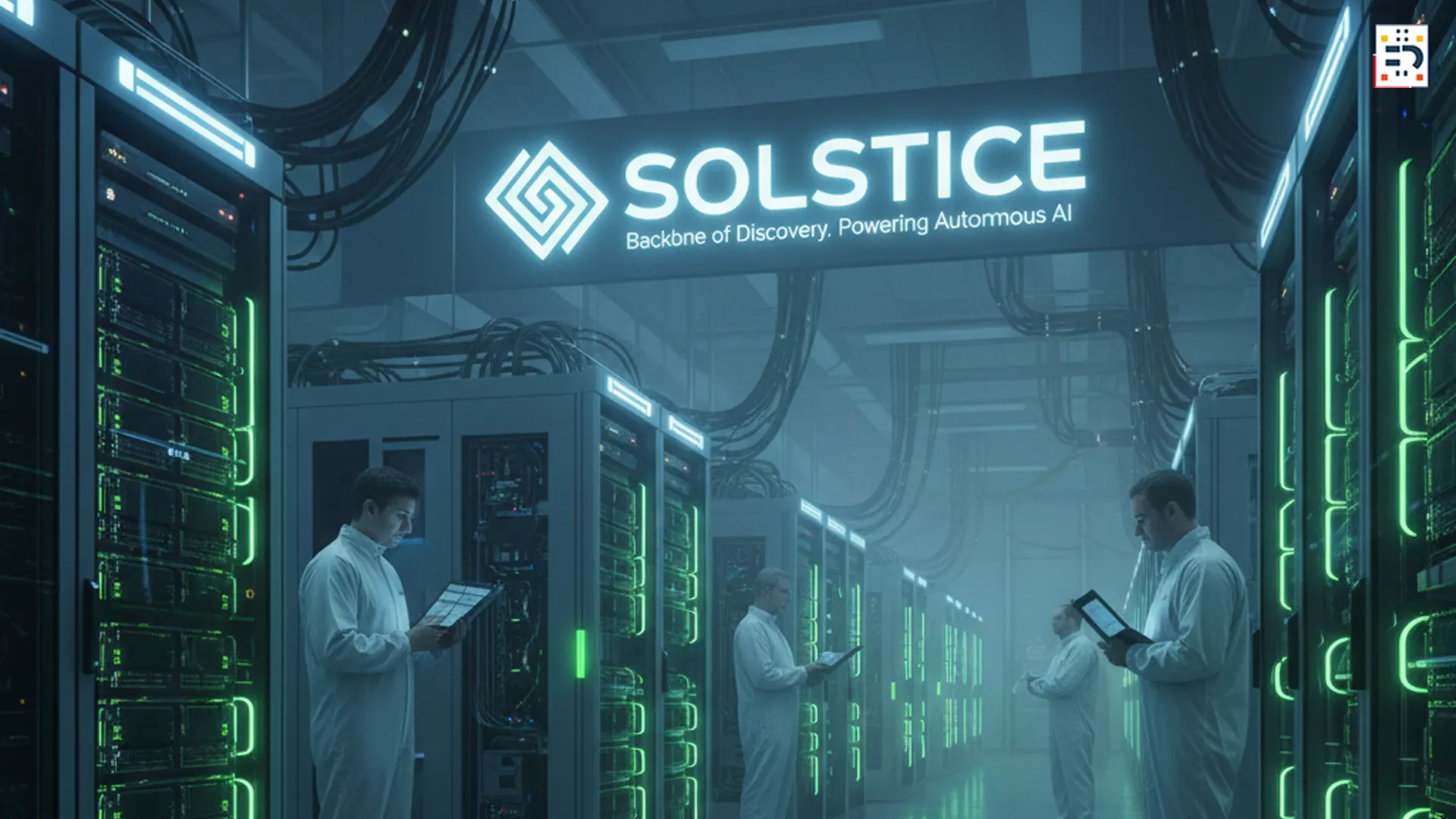Breaking: The Dawn of Autonomous AI-Powered Scientific Discovery
In a groundbreaking development that’s reshaping the future of research, artificial intelligence systems are now conducting independent scientific research—formulating hypotheses, designing experiments, analyzing data, and writing peer-reviewed papers with minimal human intervention. This isn’t science fiction; it’s happening right now in laboratories across America, backed by billions in investments from the US government and tech giant Nvidia.
Just this week, Nvidia and Oracle announced plans to build the US Department of Energy’s largest AI supercomputer for scientific discovery, with the Solstice system featuring a record-breaking 100,000 Nvidia Blackwell GPUs and the Equinox system featuring 10,000 Blackwell GPUs. These systems, both located at Argonne National Laboratory, will support collaborations to develop “agentic scientists” aimed at boosting R&D productivity and accelerating discovery within a decade.
The stakes couldn’t be higher. As Nvidia CEO Jensen Huang declared at the GTC Washington D.C. conference, the nation is at the dawn of an AI industrial revolution that will define every industry’s future.
What is an ‘Agentic Scientist’? Understanding Autonomous AI Research
Defining Agentic AI in Scientific Research
Unlike traditional AI tools that simply assist researchers, agentic scientists are autonomous systems capable of executing the complete scientific method independently. These cutting-edge systems represent the next evolution in artificial intelligence for scientific discovery.
Key capabilities of agentic AI scientists include:
- Iteratively formulating scientific hypotheses
- Designing and executing complex experiments
- Analyzing and visualizing massive datasets
- Autonomously authoring scientific manuscripts
- Conducting literature reviews and peer analysis
- Self-correcting and optimizing research methodologies
Recent Breakthroughs in AI-Driven Research
The progress in autonomous research systems has been remarkable. Recent developments have shown AI systems producing research papers that meet peer-review standards, with some manuscripts achieving scores exceeding human acceptance thresholds. This represents a watershed moment in the intersection of machine learning and scientific methodology.
Researchers at Stanford University have created “virtual labs” with AI principal investigators and specialized scientist agents that hold meetings, debate ideas, and solve complex biological problems, often discovering new findings beyond what previous human researchers published.
Learn more about AI research capabilities from Nvidia’s AI Research Blog.

The $1+ Billion Government-Industry Alliance: Building America’s AI Backbone
Massive Federal Investment in AI Infrastructure
The Trump Administration has made AI-driven scientific discovery a national priority, reflecting its commitment to securing America’s leadership through the DOE’s new public-private partnership model.
Department of Energy’s Revolutionary Supercomputer Network
The Solstice and Equinox supercomputers at Argonne National Laboratory will be interconnected by Nvidia networking and deliver a combined 2,200 exaflops of AI performance. These systems will enable scientists to develop and train frontier models for open science, forming the backbone of agentic AI workflows for scientific discovery.
Additionally, the US Department of Energy formed a $1 billion partnership with AMD to construct two supercomputers called Lux and Discovery that will tackle large scientific problems ranging from nuclear power to cancer treatments to national security. The Lux system will be deployed in early 2026, while Discovery is expected to be operational by 2029.
Visit the National Science Foundation for updates on federal AI initiatives.
NSF-Nvidia Partnership: Open AI Models for Researchers
The US National Science Foundation announced a partnership with Nvidia to develop AI models that will transform America’s scientists’ ability to leverage AI, with NSF contributing $75 million and Nvidia providing an additional $77 million to support the Open Multimodal AI Infrastructure to Accelerate Science (OMAI) project, led by the Allen Institute for AI (Ai2).
This collaboration advances priorities from the White House AI Action Plan to accelerate AI-enabled science and ensure the United States produces leading open models that enhance America’s global AI dominance.
Check Nvidia Newsroom for the latest announcements.
National Laboratory Deployments
Major national laboratories are receiving cutting-edge AI infrastructure:
- Los Alamos National Laboratory: Selected the Nvidia Vera Rubin platform for its next-generation systems
- Argonne National Laboratory: Unveiling three powerful Nvidia-based systems—Tara, Minerva, and Janus
- Oak Ridge National Laboratory: Hosting the Lux AI supercomputer for energy and national security research
- Berkeley Lab: Developing the Doudna supercomputer with Dell Technologies and Nvidia
Learn about these facilities at the Department of Energy website.
Secure AI for Government Operations: National Security Meets Innovation
AI Factory for Government Initiative
Nvidia recently unveiled its AI Factory for Government, a secure AI blueprint for federal agencies that modernizes public sector AI with advanced security and industry partners for mission-critical deployments. The reference design includes the latest Nvidia AI Enterprise software designed to meet stringent security standards for FedRAMP-authorized clouds and high-assurance environments.
Defense Contractor Integration
Major defense contractors are rapidly adopting agentic AI:
Lockheed Martin’s Astris AI Factory, commercially available after five years of internal use, will use Nvidia AI Enterprise software to develop and deploy AI agents for missions requiring trust and precision. Northrop Grumman is deploying an AI factory to enable advanced AI capabilities across its workforce of nearly 100,000 employees.
These developments position artificial intelligence as central to national security infrastructure.
Read more at Lockheed Martin and Northrop Grumman.

The Private Sector AI Revolution: Race to Build Computational Power
Data Center Expansions and AI Infrastructure
Beyond government initiatives, private companies are racing to build AI infrastructure at unprecedented scale:
xAI is developing its massive Colossus 2 data center in Memphis, Tennessee, which will house over half a million Nvidia GPUs for rapid frontier-level AI model training and inference.
Together AI, partnering with 5C, operates an AI factory in Maryland featuring Nvidia B200 GPUs and is bringing another online in Memphis with Nvidia GB200 and GB300 systems.
Enterprise AI Adoption
HPE and Nvidia are collaborating to speed government and enterprise AI adoption. One of the first deployments is in Vail, Colorado, where the city is piloting an Agentic Smart City framework using autonomous AI agents to manage citywide systems in real time.
Nvidia CEO Jensen Huang announced at GTC that Blackwell graphics processing units are now in full production in Arizona, with 6 million Blackwell GPUs shipped in the last four quarters.
Explore enterprise solutions at Hewlett Packard Enterprise.
Real-World Applications: How Agentic AI is Transforming Industries
Healthcare and Drug Discovery Revolution
Google DeepMind, Isomorphic Labs, and other Alphabet teams are working with Nvidia to use AI and simulation to reimagine drug discovery, potentially accelerating the development of new treatments by orders of magnitude.
Energy Secretary Chris Wright stated that the supercomputers would help manage the US arsenal of nuclear weapons and accelerate drug discovery by simulating ways to treat cancer down to the molecular level, with hopes of turning most cancers into manageable conditions within five to eight years.
Fortanix and Nvidia have partnered to enable confidential AI in healthcare, allowing enterprises to run AI on sensitive patient data with verifiable trust and compliance.
Visit Google DeepMind for AI health innovations.
Cybersecurity Applications
VAST Data Federal and Leidos introduced agentic cybersecurity solutions powered by Nvidia AI that bring accelerated detection and AI-ready data foundations to security pipelines. These agentic workflows correlate evidence, construct timelines, and can recommend or execute actions like rerouting traffic or closing ports.
Materials Science and Energy Innovation
Siemens and Switch have built digital twin solutions to model and optimize AI factory lifecycles, with AI agents continuously optimizing power, cooling, and workloads to boost grid flexibility, resilience, and energy efficiency.
Discover more at Siemens.
The Challenges: Navigating the Path to Autonomous Science
Current Limitations of AI Research Systems
Despite progress, several challenges remain for autonomous AI scientists:
- Struggles with tasks requiring deep domain-specific knowledge
- Questions about effective human-AI collaboration frameworks
- Issues with generalizability across different scientific domains
- High failure rates in literature review phases
- Concerns about reproducibility and verification
Ethical and Workforce Considerations
Critics worry that automation could limit opportunities for young researchers and question whether AI possesses the creative thinking necessary for groundbreaking discoveries. Some researchers advocate for involving experts from philosophy of science, anthropology, and epistemology to design more thoughtful experiments.
However, proponents argue that AI-generated research can excel in open-ended exploration when leveraging internal knowledge synthesis rather than following prescriptive directives.
The Telecommunications Revolution: Nvidia-Nokia Partnership
Building America’s 5G and 6G Infrastructure
Huang announced Nvidia would partner with Finland-based Nokia to build gear for telecommunications, with Nvidia taking a $1 billion stake in Nokia and building chips for 5G and 6G base stations based on American technology.
This partnership addresses Western policymakers’ concerns about Chinese technology from Huawei in cellular networks worldwide, representing a strategic move to secure America’s communication infrastructure.
Learn more at Nokia.
Quantum Computing Integration: The Next Frontier
NVQLink: Connecting Quantum and Classical Computing
At GTC Washington D.C., Nvidia introduced NVQLink, an open system architecture designed to connect GPU-accelerated supercomputers directly with quantum processors. Nvidia said 17 different quantum computing startups would produce hardware compatible with NVQLink, allowing researchers to orchestrate quantum devices and AI supercomputers to run quantum GPU applications.
This integration of quantum computing and AI represents the cutting edge of computational science.
Global Competitiveness: America’s AI Century
The New Apollo Moment
The parallels to the space race are intentional. Just as America’s investment in NASA drove decades of innovation, the current push to build AI-driven scientific infrastructure represents a generational investment in discovery capacity.
Jensen Huang stated: “AI is the most powerful technology of our time, and science is its greatest frontier. Together with Oracle, we’re building the Department of Energy’s largest supercomputer that will serve as America’s engine for discovery”.
Manufacturing Returns to American Soil
Huang revealed that President Donald Trump asked him nine months ago to bring manufacturing back to US shores, stating “The first thing that President Trump asked me for is bring manufacturing back because it’s necessary for national security”.
Nvidia’s Blackwell-based systems are now being assembled in the US, marking a significant shift in semiconductor manufacturing strategy.

The Road Ahead: Timeline and Expectations
Near-Term Developments (2025-2026)
- Q1 2026: Equinox system with 10,000 Blackwell GPUs operational
- Early 2026: Lux AI supercomputer deployment at Oak Ridge
- Mid-2026: Berkeley Lab’s Doudna supercomputer launch
- Late 2026: Full operational capacity of Argonne systems
Long-Term Vision (2027-2030)
- 2027-2028: Integration of quantum computing with AI systems
- 2028: Discovery supercomputer operational at Oak Ridge
- 2029: Full realization of “agentic scientist” capabilities
- 2030s: Exponential acceleration in scientific discovery rates
The direction is clear—agentic scientists are moving from prototypes to scalable systems reshaping how knowledge is created.
Industry Recognition and Innovation Awards
At GTC 2025, Nvidia recognized 14 partners driving agentic and physical AI, debuting new Trailblazer, Rising Star, and Innovation awards.
Tata Consultancy Services earned recognition for launching an Nvidia-powered AI unit and center accelerating global adoption of agentic AI.
Visit Nvidia GTC for conference information.
FAQ: Understanding Agentic AI Scientists
Q: What is an agentic AI scientist?
A: An autonomous AI system conducts research from hypothesis to publication with minimal human involvement
Q: How much is the US government investing in AI for science?
A: Federal investments include $75 million from the NSF, $1 billion for AMD supercomputers, and further funding for Nvidia-Oracle systems.
Q: When will agentic scientists be fully operational?
A: Initial systems are launching in 2025-2026, with full capabilities expected by the end of the decade.
Q: What are the main applications?
A: Drug discovery, materials science, energy research, climate modeling, cybersecurity, and national defense.
Q: Will AI replace human scientists?
A: No, agentic AI is designed to augment and accelerate human research, not replace scientists.
The Transformation is Already Here
The agentic scientist isn’t just coming—it’s already here, conducting research, analyzing data, and pushing the boundaries of what’s possible. Whether it accelerates discovery or redefines it entirely, one truth remains: the age of autonomous science has begun.
The collaboration between Nvidia, the US Department of Energy, national laboratories, and private industry is creating an AI infrastructure that will define American technological leadership for generations. From the 100,000 GPU Solstice supercomputer to quantum-integrated systems, from autonomous drug discovery to national security applications, the agentic AI revolution is reshaping science at unprecedented scale.
The question now isn’t whether agentic scientists will transform research, but how quickly—and whether America will lead that transformation. With billions in investment, advanced infrastructure, and top minds working together, one thing is clear: America’s AI century has arrived.
#AgenticAI #NvidiaAI #ArtificialIntelligence #ScientificDiscovery #AIResearch #MachineLearning #DeepLearning #TechInnovation #AIScience #FutureOfScience #HealthTech #BioTech #CyberSecurity #CleanEnergy


